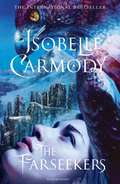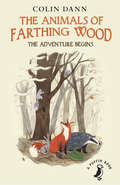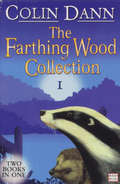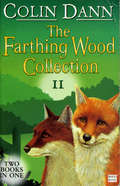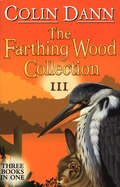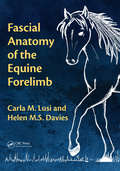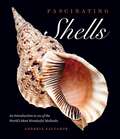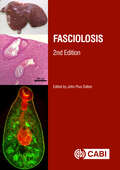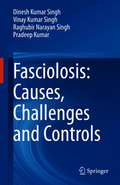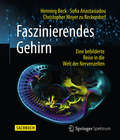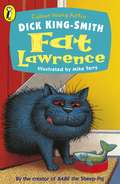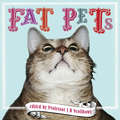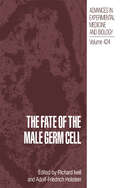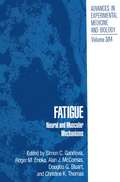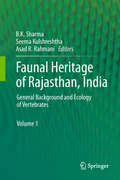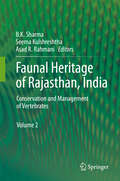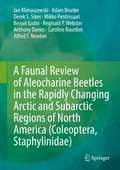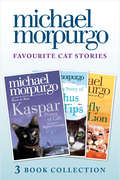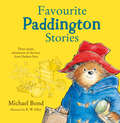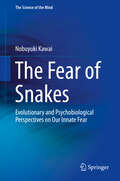- Table View
- List View
The Farseekers: Obernewtyn Chronicles: Book Two (The\obernewtyn Chronicles #Bk. 2)
by Isobelle CarmodySince their takeover of Obernewtyn, Elspeth and the Misfits have been preparing for the inevitable confrontation with the Council - developing their forbidden mental abilities so they are ready for battle. But in the midst of plans to rescue a powerful Misfit, it is foreseen by a futureteller that the fate of Obernewytn is inextricably bound up with their quest.Led by Elspeth, whose extraordinary powers set her apart from her Misfit friends, the expedition sets out on its danger-filled task.
Farthing Wood - The Adventure Begins: The Adventure Begins (Farthing Wood Ser. #Vol. 2)
by Colin DannThere had always been otters in the stream running through Farthing Wood - and that had never been a problem for the other animals before: both sets of animals were happy to leave each other alone.But when there is a shortage of fish in the stream, the otters take to coming ashore for new prey - and that is a problem. Suddenly, the Farthing Wood animals have to compete for food - and they don't like it. Lean Vixen and the others are determined not to starve, and that means deciding on a plan to drive the otters out once and for all . . .
Farthing Wood Collection 1
by Colin DannThe first two stories about the Animals of Farthing Wood have been brought together in one, value for money bind-up. In the prequel to The Animals of Farthing Wood, THE ADVENTURE BEGINS we meet an earlier generation of animals whose descendants will make their epic journey from Farthing Wood to White Deer Park. Then read how the animals survived their first and harshest winter away from Farthing Wood in IN THE GRIP OF WINTER.
The Farthing Wood Collection 2
by Colin DannA second collection of stories about the Animals of Farthing Wood brought together in one volume. In FOX'S FEUD young fox cub, Dreamer, has been killed in a vicious attack, and the animals in White Deer Park have no doubt who is responsible. Fox vows revenge, but are he and his young family a match for the formidable strength of Scarface and his clan? Yet again the animals must band together to avert disaster. FOX CLUB BOLD sees Dreamer’s brother, Bold, venture into dangerous territory in an attempt to make peace with the enemy. Despite his good intentions, Bold is imprisoned and Fox has to come to his rescue.
Farthing Wood Collection 3
by Colin DannThe Siege of White Deer Park: the animals are in danger and they need to make a plan - fast! A killer beast is on the loose and the deaths are mounting up... In the Path of the Storm: when the new leader of the stag herd, Trey, wields his power, things look very bleak for the smaller animals. They are to be evicted! That is, until the night of the great storm. Battle for the Park: Animals are disappearing from the White Deer Park. Could the Warden, whom the animals have learnt to trust, be responsible?
Fascial Anatomy of the Equine Forelimb
by Carla M. Lusi Helen M.S. DaviesKey features: The first book in equine anatomy to illustrate the fascial (soft connective tissue) connections of the equine forelimb. Clear, high-quality images (with reference images included on each page) help readers identify aspects of the limb photographed. A brief introduction to the forelimb musculoskeletal anatomy (with images) helps readers familiarize themselves with muscles and bones portrayed in photographs. Focused discussions highlight the practical applicability of the fascial connections illustrated. Accompanying video clips demonstrate connectivity of the fascial system particular lines of tension. The first of its kind in equine anatomy, this clear, concise anatomical guide illustrates the fascial (soft connective tissue) connections of the equine forelimb. Based on dissections of fresh equine cadaver limbs, it provides a visual map for equine physical therapists, veterinarians and horse riders, helping them to understand how pathologies, injuries, or movement abnormalities of the equine forelimb arise and/or progress from one area of the limb to another. The fascial system is one of the primary systems acted upon by equine physiotherapists and is of increasing interest to horse riders looking to achieve structural integration and balanced movement in their horse. With this in mind, key points in each chapter highlight everyday situations in which knowledge of the fascial system may assist in understanding horse movement and injury. This practically applicable anatomical atlas is the ideal reference for horse owners, body workers and veterinarians alike.
Fascial Anatomy of the Equine Forelimb
by Carla M. Lusi Helen M.S. DaviesLusi and Davies have provided an excellent reference resource for students and graduates alike. The number of well-defined, relevant and clear images allow quick understanding for anyone interested in the fascial anatomy of the horse. This small book is perfect to have in your bag, allowing the student or clinician to find all the information they need on-site. - Sophie Neasham, final year veterinary student, University of Veterinary Medicine in Kosice, Slovakia Key features: The first book in equine anatomy to illustrate the fascial (soft connective tissue) connections of the equine forelimb. Clear, high-quality images (with reference images included on each page) help readers identify aspects of the limb photographed. A brief introduction to the forelimb musculoskeletal anatomy (with images) helps readers familiarize themselves with muscles and bones portrayed in photographs. Focused discussions highlight the practical applicability of the fascial connections illustrated. Accompanying video clips demonstrate connectivity of the fascial system particular lines of tension. The first of its kind in equine anatomy, this clear, concise anatomical guide illustrates the fascial (soft connective tissue) connections of the equine forelimb. Based on dissections of fresh equine cadaver limbs, it provides a visual map for equine physical therapists, veterinarians and horse riders, helping them to understand how pathologies, injuries, or movement abnormalities of the equine forelimb arise and/or progress from one area of the limb to another. The fascial system is one of the primary systems acted upon by equine physiotherapists and is of increasing interest to horse riders looking to achieve structural integration and balanced movement in their horse. With this in mind, key points in each chapter highlight everyday situations in which knowledge of the fascial system may assist in understanding horse movement and injury. This practically applicable anatomical atlas is the ideal reference for horse owners, body workers and veterinarians alike.
Fascinating Shells: An Introduction to 121 of the World’s Most Wonderful Mollusks
by Andreia SalvadorBeautiful photographs of stunning shells from London's Natural History Museum, home to one of the most significant and comprehensive collections in the world. Collected and treasured for their beauty, used in religious rituals, or even traded as currency, shells have fascinated humans for millennia. Ancient and enchanting, dazzling in form and variety, these beautiful objects come from mollusks, one of the most diverse groups in the animal kingdom, including snails, oysters, cuttlefish, and chitons. Soft-bodied, these creatures rely on shells for protection from enemies and their environments, from snowy mountains to arid deserts, in deep-sea hydrothermal vents and the jungles of the tropics, on rocky shores, and in coral reefs. In this book, mollusk expert Andreia Salvador profiles some of the world’s most beautiful and quirky shells, each selected from the more than eight million specimens held in the collection at London’s Natural History Museum. We lock eyes with the hundred-eyed cowry, named after "the all-seeing one," the giant Argus Panoptes of Greek mythology. We see how shells' appearances translate into defense strategies, as with the zigzag nerite, which varies its patterning to deceive and confuse predators. And we meet shell inhabitants, such as the amber snail, which eats earthworms by sucking them up like spaghetti. Reproduced in full color and striking detail, these shells have much to reveal about the history of collecting, the science of taxonomy, and the human desire to understand the natural world.
Fascinating Shells: An Introduction to 121 of the World’s Most Wonderful Mollusks
by Andreia SalvadorBeautiful photographs of stunning shells from London's Natural History Museum, home to one of the most significant and comprehensive collections in the world. Collected and treasured for their beauty, used in religious rituals, or even traded as currency, shells have fascinated humans for millennia. Ancient and enchanting, dazzling in form and variety, these beautiful objects come from mollusks, one of the most diverse groups in the animal kingdom, including snails, oysters, cuttlefish, and chitons. Soft-bodied, these creatures rely on shells for protection from enemies and their environments, from snowy mountains to arid deserts, in deep-sea hydrothermal vents and the jungles of the tropics, on rocky shores, and in coral reefs. In this book, mollusk expert Andreia Salvador profiles some of the world’s most beautiful and quirky shells, each selected from the more than eight million specimens held in the collection at London’s Natural History Museum. We lock eyes with the hundred-eyed cowry, named after "the all-seeing one," the giant Argus Panoptes of Greek mythology. We see how shells' appearances translate into defense strategies, as with the zigzag nerite, which varies its patterning to deceive and confuse predators. And we meet shell inhabitants, such as the amber snail, which eats earthworms by sucking them up like spaghetti. Reproduced in full color and striking detail, these shells have much to reveal about the history of collecting, the science of taxonomy, and the human desire to understand the natural world.
Fasciolosis
by John P. DaltonFasciolosis is a major global infection of livestock causing both huge losses to the agricultural community and affecting human health as a food-borne disease. Fully updated throughout, this new edition continues to cover the life cycle, biology, and development of the parasite; clinical pathology, immunology, diagnosis and vaccine development; and emergence, cause and mechanisms of drug resistance. It reviews the temperate liver fluke Fasciola hepatica, together with molecular, biochemical, control, and epidemiologial aspects of the tropical liver fluke F. gigantica. Many fundamental advances have taken place in the last two decades, but of particular importance has been the mapping of the draft genome of Fasciola. In addition, comprehensive advances in transcriptomics, proteomics and glycomics have been made, and the book therefore pays particular attention to these developments with the addition of brand-new chapters. Also covering the impact these parasites have had on the global human population, their distribution and their ecology, this book provides a comprehensive and accessible resource for scientists, researchers and students of medical and veterinary parasitology.
Fasciolosis: Causes, Challenges and Controls
by Dinesh Kumar Singh Vinay Kumar Singh Raghubir Narayan Singh Pradeep KumarThis book provides an up-to-date review of fasciolosis, a disease caused by Fasciola hepatica and Fasciola gigantica, including its biology, transmission, epidemiology, host distribution, economic impact, and novel approaches for its diagnosis, treatment and prevention.It first offers a brief overview of the history of the disease, the genetic diversity of the parasite and its distribution, and the ecology of the vector snail, which belongs to the Lymnaeidae/Planorbidae family. It also examines the current strategies and novel approaches for controlling the parasite, diagnosing infections and vaccine development.Importantly, it highlights issues relating to the control of fasciolosis, including drug resistance, lack of effective diagnostics, and the parasite’s long-term survival strategies based on regulation and modulation of the host immune system. Lastly, it discusses the novel control snail vectors using bait formulations, and synergetic and phototherapy treatment with chlorophyllin, which does not kill the vector.
Faszinierendes Gehirn: Eine bebilderte Reise in die Welt der Nervenzellen
by Henning Beck Sofia Anastasiadou Christopher Meyer zu ReckendorfVon den spektakulären Windungen des Großhirns bis zu den filigranen Formen einzelner Nervenzellen – von den einzigartigen Schleifen, Schichten und Schlaufen des Kleinhirns bis in die feinen Verästelungen der Nervenfasern unserer Muskeln – von der Funktion unserer Sinne bis an die Grenzen der modernen Hirnforschung: Dieses Buch nimmt Sie mit in die spannende Welt des Gehirns und bietet atemberaubende Einblicke in die Architektur und Funktion der Nervenzellen.Doppelseitige Kurzkapitel, gespickt mit spektakulären Abbildungen, stellen jeweils ein konkretes Thema der Neurobiologie kompakt und verständlich vor. Faszinierende und zum Teil noch nie gezeigte Aufnahmen verdeutlichen die ganze Ästhetik der Welt in unserem Kopf und machen Lust auf die Wissenschaft der Nervenzellen. Ein Buch zum Durchlesen, Querlesen und Vorlesen. Für jeden, der sich für das Gehirn interessiert. Ohne unnötige Fachbegriffe, dafür mit viel Begeisterung für eine der spannendsten Wissenschaften unserer Zeit.
Faszinierendes Gehirn: Eine bebilderte Reise in die Welt der Nervenzellen
by Henning Beck Sofia Anastasiadou Christopher Meyer zu ReckendorfVon den spektakulären Windungen des Großhirns bis zu den filigranen Formen einzelner Nervenzellen – von den einzigartigen Schleifen, Schichten und Schlaufen des Kleinhirns bis in die feinen Verästelungen der Nervenfasern unserer Muskeln – von der Funktion unserer Sinne bis an die Grenzen der modernen Hirnforschung: Dieses Buch nimmt Sie mit in die spannende Welt des Gehirns und bietet atemberaubende Einblicke in die Architektur und Funktion der Nervenzellen.Doppelseitige Kurzkapitel, gespickt mit spektakulären Abbildungen, stellen jeweils ein konkretes Thema der Neurobiologie übersichtlich und verständlich vor. Faszinierende und zum Teil noch nie gezeigte Aufnahmen verdeutlichen die ganze Ästhetik der Welt in unserem Kopf und machen Lust auf die Wissenschaft der Nervenzellen. Ein Buch zum Durchlesen, Querlesen und Vorlesen. Für jeden, der sich für sein Gehirn interessiert. Ohne unnötige Fachbegriffe, dafür mit viel Begeisterung für eine der spannendsten Wissenschaften unserer Zeit.
Fat Lawrence
by Dick King-SmithA very funny animal story from the award-winning writer Dick King-SmithLaurence Higgins, an enormously fat black cat, has breakfast with Mrs Higgins, lunch with the Normans, tea with old Mr Mason and supper with the Barclay-Lloyds. None of them know why he is so fat on just one meal a day! Lawrence is happy until he finds the walking from house to house tiring and begins to get indigestion. His friends tell him to lose weight if he wants a girl friend so he begins to spend one day in four with all his owners. He gets thinner but the cat he fancies down the road tells him she doesn't like slim boys - she's lost her heart to an enormously fat black cat she used to see up the road! Triumphantly Lawrence returns to his four meals a day, spurred on by the thought of meeting Bella when he's back to his normal size.
Fat Pets
by Professor J. D. ScoffbowlIt’s the ideal Christmas gift – the first ever collection of pictures of the world’s fattest pets! Marvel at the supersized cats, dogs, rabbits and others to be found in this astounding and entertaining book. Will fit in most stockings.
The Fate of the Male Germ Cell (Advances in Experimental Medicine and Biology #424)
by Richard Ivell Adolf-Friedrich HolsteinTHE FASCINATION The male germ cell is the only cell of the human organism that leaves the body when it has achieved its final, highly sophisticated structure and properties. The male germ cell is designed for one purpose only: to reach the female gametes and to fertilize them. The various stages in the development of the male germ cell are characterized by proliferative phases, by the recombination of the maternal and paternal chromosomes, and by the differentiation and development of a specialized transport vehicle, the spermato zoon. Furthermore, the establishment of a special pool of stem cells, the spermatogonia, guarantees the continuity of the sperm-generation process from puberty to old age. THE FATE OF THE MALE GERM CELL The destiny of any individual germ cell is determined by a program that we know only in fragments. On the one hand every human male is able to produce many billions of germ cells in his lifetime, yet the chance of any single sperm reaching and fertilizing the female germ cell is exceedingly rare. A fertility disturbance means that somewhere during the complicated playing out of the germ cell program mistakes are made, and the program fails. It is still a fact that more than 50% of men presenting with male factor infertility have to be diagnosed as idiopathic, largely because of our lack of knowledge and conse quent lack of appropriate diagnostic tools.
Fatigue: Neural and Muscular Mechanisms (Advances in Experimental Medicine and Biology #384)
by Patricia A. PierceThis volume describes the current state of our knowledge on the neurobiology of muscle fatigue, with consideration also given to selected integrative cardiorespiratory mechanisms. Our charge to the authors of the various chapters was twofold: to provide a systematic review of the topic that could serve as a balanced reference text for practicing health-care professionals, teaching faculty, and pre-and postdoctoral trainees in the biomedi cal sciences; and to stimulate further experimental and theoretical work on neurobiology. Key issues are addressed in nine interrelated areas: fatigue of single muscle fibers, fatigue at the neuromuscular junction, fatigue of single motor units, metabolic fatigue studied with nuclear magnetic resonance, fatigue of the segmental motor system, fatigue involving suprasegmental mechanisms, the task dependency of fatigue mechanisms, integrative (largely cardiorespiratory) systems issues, and fatigue of adapted systems (due to aging, under-and overuse, and pathophysiology). The product is a volume that provides compre of processes that operate from the forebrain to the contractile proteins.
Faunal Heritage of Rajasthan, India: General Background and Ecology of Vertebrates
by B. K. Sharma, Seema Kulshreshtha and Asad R. RahmaniThis is the first ever monumental and scientific documentation of the faunal wealth of the Indian Desert state of Rajasthan. This volume, the first of two, provides background on Rajasthan and covers species diversity and distribution of fauna. A scholarly contribution to the field of knowledge, it provides novel and vital information on the vertebrate faunal heritage of India’s largest state. Broadly falling under the Indo-Malaya Ecozone, the three major biomes of Rajasthan include deserts and xeric shrublands, tropical and subtropical dry broadleaf forests, and tropical and subtropical moist broadleaf forests. The corresponding ecoregions to the above biomes are, respectively, the Thar Desert and northwestern thorn scrub forests, the Khathiar-Gir dry deciduous forests, and the Upper Gangtic Plains moist deciduous forests. Contrary to popular belief, the well-known Thar or Great Indian Desert occupies only a part of the state. Rajasthan is diagonally divided by the Aravalli mountain ranges into arid and semi-arid regions. The latter have a spectacular variety of highly diversified and unique yet fragile ecosystems comprising lush green fields, marshes, grasslands, rocky patches and hilly terrains, dense forests, the southern plateau, fresh water wetlands, and salt lakes.Apart from the floral richness, there is faunal abundance from fishes to mammals. In this volume, the various flagship and threatened species are described in the 24 chapters penned by top notch wildlife experts and academics. The world famous heronry, tiger reserves, wildlife sanctuaries and some threat-ridden biodiversity rich areas shall certainly draw the attention of readers from around the world.
Faunal Heritage of Rajasthan, India: Conservation and Management of Vertebrates
by B.K. Sharma, Seema Kulshreshtha and Asad R RahmaniThis is the first ever monumental and scientific documentation of the faunal wealth of the Indian Desert state of Rajasthan. This volume, the second of two, provides a comprehensive picture of the conservation efforts undertaken to prevent further degradation of the condition of Rajasthan’s faunal wealth. A scholarly contribution to the field of knowledge, it provides novel and vital information on wildlife preservation initiatives in India’s largest state. Broadly falling under the Indo-Malaya Ecozone, the three major biomes of Rajasthan include deserts and xeric shrublands, tropical and subtropical dry broadleaf forests, and tropical and subtropical moist broadleaf forests. The corresponding ecoregions to the above biomes are, respectively, the Thar Desert and northwestern thorn scrub forests, the Khathiar-Gir dry deciduous forests, and the Upper Gangetic Plains moist deciduous forests. Contrary to popular belief, the well-known Thar or Great Indian Desert occupies only a part of the state. Rajasthan is diagonally divided by the Aravalli mountain ranges into arid and semi-arid regions. The latter have a spectacular variety of highly diversified and unique yet fragile ecosystems comprising lush green fields, marshes, grasslands, rocky patches and hilly terrains, dense forests, the southern plateau, fresh water wetlands, and salt lakes. Apart from the floral richness, there is faunal abundance from fishes to mammals. In this volume, the various flagship and threatened species are described in the 20 chapters penned by top notch wildlife experts and academics. The world famous heronry, tiger reserves, wildlife sanctuaries and some threat-ridden biodiversity-rich areas shall certainly draw the attention of readers from around the world.
A Faunal Review of Aleocharine Beetles in the Rapidly Changing Arctic and Subarctic Regions of North America (Coleoptera, Staphylinidae)
by Anthony Davies Jan Klimaszewski Reginald P. Webster Adam Brunke Caroline Bourdon Alfred F. Newton Benoit Godin Derek S. Sikes Mikko PentinsaariArctic and Subarctic North America is particularly affected by climate change, where average temperatures are rising three times faster than the global average. Documenting the changing climate/environment of the north requires a structured knowledge of indicator taxa that reflect the effects of climate changes.Aleocharine beetles are a dominant group of forest insects, which are being used in many projects as indicators of environmental change. Many species are forest specialists restricted to certain microhabitats, some are generalists and others are open habitat specialists. They represent many ecological niches and, as such, are good indicators for many other species as well. The majority of Canadian aleocharine beetle species (about 600 spp.) has been studied and published by Jan Klimaszewski et al. (2018, 2020), mainly from southern, central, and western Canada, while the northern taxa remain poorly known and documented. The aim of the present book is to summarize the knowledge on this insect group in the Arctic and Subarctic North America and to provide a diagnostic and ecological tool for scientists studying and monitoring insects in northern Canada and Alaska. The book includes a review of the literature, information on 238 species and their habitats, taxonomic review, images, and identification tools.
Favourite Cat Stories: The Amazing Story of Adolphus Tips, Kaspar and The Butterfly Lion
by Michael MorpurgoThree beautiful tales for all feline-lovers told by the nation’s favourite storyteller including wartime kittens and African lion cubs.
Favourite Dog Stories: Shadow, Cool! and Born to Run
by Michael MorpurgoTales from the nation’s favourite storyteller about man’s best friend who will do anything to protect their loving owners.
Favourite Paddington Stories: Paddington in the Garden, Paddington at the Carnival, Paddington and the Grand Tour (Paddington)
by Michael BondThree favourite stories of Paddington, the beloved classic bear from Darkest Peru, brought together in one volume. Paddington is now a major movie star!
The Fear of Snakes: Evolutionary and Psychobiological Perspectives on Our Innate Fear (The Science of the Mind)
by Nobuyuki KawaiThis book provides a series of compelling evidence that shows that humans have innate fear of snakes. Building on the previous studies on the Snake Detection Theory (SDT), the author presents a summary of psychological and neuropsychological experiments to explain the fear of snakes in humans and primates. Readers will come to understand why and how we are afraid of snakes from an evolutionary perspective.The first half of the book discusses the history of psychological behaviorism and neobehaviorism. The latter half of the book consists mainly of the experimental studies performed by the author with a focus on three key items: First, compared with other animals, snakes especially draw the attention of primates and humans. Second, the ability of primates and humans to recognize snakes with particular efficiency. Third, processing mechanisms within the brain for snake detection is discussed from a new viewpoint.The book offers a unique resource for all primatologists, psychologists, neuroscientists, anthropologists, herpetologists, and biologists who are interested in the evolution of visual and cognitive systems, mechanisms of fear, snakes or primates.
Fearless Under Fire: Tangye
by Isabel GeorgeAn inspiring and heart-warming short story of canine devotion and bravery.
